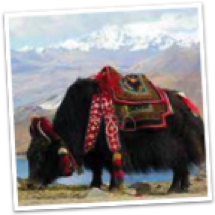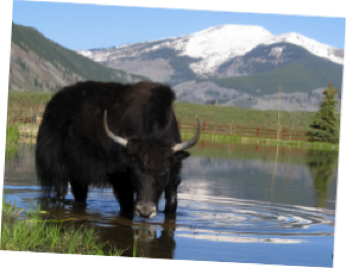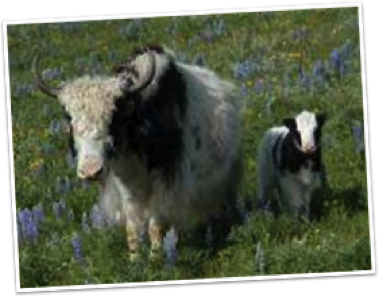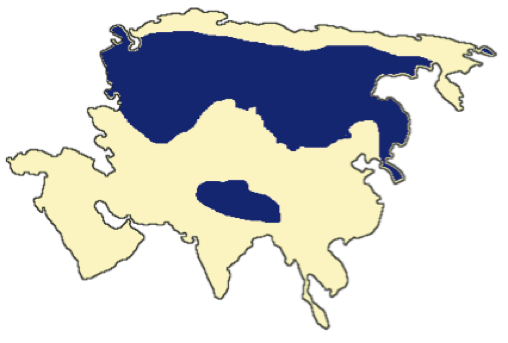
Uses
The indigenous peoples of Asia have completely depended on yaks to sustain life for thousands of years, either directly or through income from commodities. Often multiple families will communally tend a herd of yak, each mutually benefiting from its products. In the poorest regions, a single yak may be shared. Almost everything from the yak is used, including their milk, meat, fleece, and dried dung for fuel. On the treeless Tibetan Plateau dried yak dung is collected daily, and burned as fuel for cooking and heating stoves.
About Me
Adult male domestic yaks typically weigh between 750 and 1,300 pounds. Females tend to be slightly smaller, weighing around 550 pounds. They are predominantly black in color, but may also be gray, cream, brown, or a spotted combination of the four. Both sexes of yaks grow horns. A bull yak’s horns grow to nearly 40 inches, while a cow’s are slightly smaller. They are generally raised in herds with 5 - 6 bulls per 100 females. Yaks have a gestation period of 8 months, and only have one calf each year. Baby yaks stay with the mother for between 12 and 18 months.
Yaks most often live at high elevations on mountain plateaus and steppes. At higher elevations there is less air pressure, making it more difficult to breathe. Yaks have a larger heart and lungs than cattle who live at lower altitudes. This allows for greater flow of oxygen to the yak’s blood. Yaks are well adapted to the cold weather with their long hair and a lack of functioning sweat glands, and they also have an additional layer of insulating fat under their skin. With the help of the adaptations, they can withstand temperatures as low as -40 degrees. Additionally the yak’s rumen, or first stomach, is larger than that of other domestic cattle. This allows them to consume and utilize lower quality forages often found in the sparse mountain environment.






Fast Facts

Snapshot
1. Yak fleece is used to produce clothing, coats, blankets, rope, and tents.
2. Yak butter is used for doughy foods, tea, lamp oil, hide tanning, and skin moisturizer.
3. Yak racing is held at traditional festivals in Tibet, Northern Pakistan, and Mongolia.
Domestic yaks, a member of the bovine (cattle) family, are found throughout Asia. They are most prevalent in places including Mongolia, Russia, south Central Asia, and the Himalayan region, including the Tibetan Plateau.
Yaks thrive in areas of high elevation with harsh weather conditions. They have been known to play in partially frozen rivers in sub-zero temperatures. A sturdy animal, yaks have a bulky frame, strong legs, and round hooves that allow them to be sure-footed on the rough and uneven mountainous terrain.
Yaks are used to sustain life through their milk, butter, meat, fleece, dung for fuel, travel, and as a draft animal.
Name: Yak
Scientific: Boselaphus grunniens grunniens
Family: Bovidae
Relatives: Water Buffalo, Bison, Musk Ox
Environment: Mountainous
Origin: Asia
Life-span: 20 years
Size: 750 - 1,300 lbs




Asia
Products
• Milk
• Meat
• Fleece
• Butter
• Rope
• Tents
• Skin moisturizer
• Blankets
• Lamp oil
• Tea
• Clothing
• Burning fuel
• Doughy foods
• Hide tanning
Fiber
Yaks have long, thick hair that is spun and used to make multiple products. The fiber is used to make clothing, blankets, rugs, and yurts (the portable native houses of Central Asia), just to name a few. The longer “shirt” hair that grows around the bottom of the yak can be spun separately, and is used for making belts and ropes. This rope is used in the construction of the yurts, as well as for other purposes.
Milk
Yaks are milked 3 times daily. Unlike most commercial dairy productions in the United States, yak calves are left with the cows, and the cows are hand milked. Depending on the location of the farm, yaks cows are tethered, kept in pens, or allowed to graze the open land. If the cows are free-range, they will be called into milking by the herdsman. They are then tethered and put into a stall to be milked, or the milker may simply take their pail to the cow and milk her in the open. The milker uses a small amount of yak butter to lubricate the udder. The milkers are able to milk a cow in an average of 6 minutes, at about 80 squeezes per minute.
Butter
Butter is a highly utilized commodity from the yak. It is most common in the groups living in the mountainous regions. Once the butter is churned, it can last up to one year if stored in a cool dry place. Different methods are used for preservation including sewing it into a bag made from the stomach of a sheep, wrapping it in the skin from a yak or wrapping it in rhododendron leaves.
The butter is made into a variety of foods, and used for many things. Yak butter tea is consumed daily throughout the Himalayas, and is even named the “Tibetan national beverage”. The butter can also be used to make a doughy food that will keep when stored and can be eaten later. When the butter has gone bad, it is the preferred substance for tanning hides. Additional uses for yak butter include as lamp fuel, skin moisturizer, and notably sculptures. Buddhist monks in Himalayan monasteries use yak butter to makes sculptures that can reach over 32 feet in height.
Draft, Sport
Yaks are also used to transport people, and as draft animals. Their ability to remain sure-footed on rough and uneven terrain makes them ideal for packing across the mountains. Yaks are also ridden with specially made saddles. At traditional festivals in Tibet and other Central Asian regions, Yak racing is considered cultural entertainment. More recently, additional sports such as yak polo and skiing have become popular.


